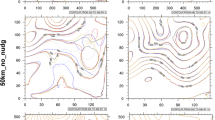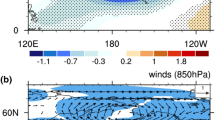Abstract
Due to the chaotic and nonlinear nature of the atmospheric dynamics, it is known that small differences in the initial conditions (IC) of models can grow and affect the simulation evolution. In this study, we perform a quantitative diagnostic budget calculation of the various diabatic and dynamical contributions to the time evolution and spatial distribution of internal variability (IV) in simulations with the nested Canadian Regional Climate Model. We establish prognostic budget equations of the IV for the potential temperature and the relative vorticity fields. For both of these variables, the IV equations present similar terms, notably terms relating to the transport of IV by ensemble-mean flow and to the covariance of fluctuations acting on the gradient of the ensemble-mean state. We show the skill of these equations to diagnose the IV that took place in an ensemble of 20 3-month (summer season) simulations that differed only in their IC. Our study suggests that the dominant terms responsible for the large increase of IV are either the covariance term involving the potential temperature fluctuations and diabatic heating fluctuations, or the covariance of inter-member fluctuations acting upon ensemble-mean gradients. Our results also show that, on average, the third-order terms are negligible, but they can become important when the IV is large.














Similar content being viewed by others
References
Alexandru A, de Elia R, Laprise R (2007) Internal variability in regional climate downscaling at the seasonal scale. Mon Weather Rev 135:3221–3238
Caya D, Biner S (2004) Internal variability of RCM simulations over an annual cycle. Clim Dyn 22:33–46
Caya D, Laprise R (1999) A semi-implicit semi-Lagrangian regional climate model: The Canadian RCM. Mon Weather Rev 127:341–362
Christensen OB, Gaertner MA, Prego JA, Polcher J (2001) Internal variability of regional climate models. Clim Dyn 17:875–887
Durran DR (1999) Numerical methods for wave equations in geophysical fluid dynamics. Springer, New York, p 465. ISBN:0-387-98376-7
Gal-Chen T, Somerville RCJ (1975) On the use of a coordinate transformation for the solution of the Navier–Stokes equations. J Comput Phys 17:209–228
Giorgi F, Bi X (2000) A study of internal variability of regional climate model. J Geophys Res 105:29503–29521
Haltiner GJ, Williams RT (1980) Numerical prediction and dynamic meteorology. Wiley, New York, p 477
Laprise R, Caya D, Giguere M, Bergeron G, Cote H, Blanchet J-P, Boer GJ, McFarlane NA (1998) Climate and climate change in Western Canada as simulated by the Canadian regional climate model. Atmos Ocean 36:119–167
Lorenz EN (1955) Available potential energy and the maintenance of the general circulation. Tellus 7:157–167
Lorenz EN (1963) Deterministic nonperiodic flow. J Atmos Sci 20:130–141
Lorenz EN (1967) The nature and theory of the general circulation of the atmosphere. World Meteorological Organization, No. 218. TP 115, 161 pp
Lucas-Picher P, Caya D, Biner S (2004) RCM’s internal variability as function of domain size. In: Côté J (ed) Research activities in atmospheric and oceanic modelling. World Meteorological Organization, 7.27–7.28
Lucas-Picher P, Caya D, de Elía R, Laprise R (2008) Investigation of regional climate models’ internal variability with a ten-member ensemble of 10-year simulations over a large domain. Clim Dyn. doi:10.1007/s00382-008-0384-8
Rinke A, Dethloff K (2000) On the sensitivity of a regional Arctic climate model to initial and boundary conditions. Clim Res 14:101–113
Rinke A, Marbaix P, Dethloff K (2004) Internal variability in Arctic regional climate simulations: case study for the Sheba year. Clim Res 27:197–209
Weisse R, Heyen H, von Storch H (2000) Sensitivity of a regional atmospheric model to a sea state dependent roughness and the need of ensemble calculations. Mon Weather Rev 128:3631–3642
Acknowledgments
This research was done as the Masters project of the first author, as a project within the Canadian Regional Climate Modelling and Diagnostic (CRCMD) Network, which is financially supported by the Canadian Foundation for Climate and Atmospheric Science (CFCAS) and the Ouranos Consortium. Ouranos also provided local facilities. The authors are indebted to Dr. G. J. Boer (CCCma) for suggesting the diagnostic methodology. We would like to thank to Mourad Labassi and Abderrahim Khaled for maintaining user-friendly local computing facility, and to Mrs Adelina Alexandru for allowing us to use her simulated data.
Author information
Authors and Affiliations
Corresponding author
Appendices
Appendix 1—Reynolds averaging and rules of averaging
Considering two variables f and g that are split into ensemble-mean and deviation parts:
Reynolds decomposition of the product gives:
so that,
and so,
The following results from 26:
If α is a constant, we also get;
From the definition of partial derivatives:
where ξ represent space or time variable.
Appendix 2—Relative vorticity equation ζ for the polar stereographic and the vertical pressure coordinates
Consider a system of the polar stereographic projection(X, Y) and the vertical pressure coordinates, the Euler equations, with the meteorological “traditional” approximation, take the following form:
where the different variables of these equations are defined as:
with λ the longitude and (x, y) the local horizontal Cartesian coordinate system.
\( K = {{\left( {U^{2} + V^{2} } \right)} \mathord{\left/ {\vphantom {{\left( {U^{2} + V^{2} } \right)} 2}} \right. \kern-\nulldelimiterspace} 2} \) and S = m2 with m = (1 + sin ψ0)/(1 + sin ψ) the map scale factor, where ψ is the latitude and ψ0 the latitude at which the plane of projection intersects the sphere.
(F X , F Y ) correspond to components of sources or sinks of momentum. These two components include surface friction, vertical diffusion and gravity wave drag. The last term of equations 33 and 34 takes into account the horizontal diffusion to parameterise the cascade of information to unresolved scale, where the constant of diffusion c for the 45-km version of the CRCM is c = 1.85.1013 m4 s−1 (Laprise et al. 1998).
f = 2Ω sinψ is the Coriolis parameter.
By adding and subtracting to equations 33 and 34 these two expressions: \( SV\left[ {{{\partial V} \mathord{\left/ {\vphantom {{\partial V} {\partial X}}} \right. \kern-\nulldelimiterspace} {\partial X}}} \right] \) and \( SU\left[ {{{\partial U} \mathord{\left/ {\vphantom {{\partial U} {\partial Y}}} \right. \kern-\nulldelimiterspace} {\partial Y}}} \right] \) respectively, we obtain:
where \( \zeta = S\left[ {{\frac{\partial V}{\partial X}} - {\frac{\partial U}{\partial Y}}} \right] \) is the relative vorticity expression.
Applying \( S \times \left[ {{\frac{{\partial \left( {B - 2} \right)}}{\partial X}} - {\frac{{\partial \left( {B - 1} \right)}}{\partial Y}}} \right] \), we obtain the relative vorticity equation:
Appendix 3—Spatial and temporal finite differencing
To derive second-order finite-difference equations, the following sum and difference operations are defined (e.g. Haltiner and Williams 1980; Durran 1999):
Appendix 4—Different terms of the IV prognostic equation for the relative vorticity
where,
and,
with
Appendix 5—Assessment of the vertical motion: \( \omega_{n} \, \left( { \equiv \frac{dp}{dt}} \right) \)
By definition, the vertical velocity can be written in this form:
where \( \phi = gz \) represents the geopotential height. Expanding the total derivative into its components gives
Using the hydrostatic equation, we can write: \( {\frac{\partial \phi }{\partial p}} = - \frac{RT}{p} \), so
All variables in this last equation are archived as the CRCM output data. Thus, the vertical motion is assessed as follow:
Thus, the vertical motion for the member n is written as:
Rights and permissions
About this article
Cite this article
Nikiema, O., Laprise, R. Diagnostic budget study of the internal variability in ensemble simulations of the Canadian RCM. Clim Dyn 36, 2313–2337 (2011). https://doi.org/10.1007/s00382-010-0834-y
Received:
Accepted:
Published:
Issue Date:
DOI: https://doi.org/10.1007/s00382-010-0834-y




